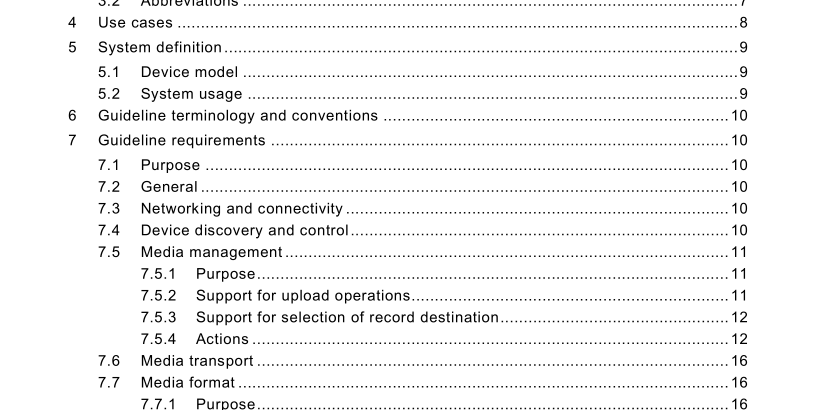IEC 62546:2009 pdf download – High definition (HD) recording link guidelines
5 System definition
5.1 Device model HD Recording Link guidelines uses the device model described in DLNA (see Clause 5 in IEC 62481-1). This subclause maps the receiver and the recorder (target devices for the guidelines) to DLNA device model. This guideline provides the requirements for the following devices:
a) RCV – receiver is a device that consists of one or more broadcasting tuner(s), an IP- based home network interface and may have storage for recording content. The storage functionality of the receiver is not covered by the guidelines;
b) REC – recorder is a device that consists of a storage for recording content (removable or non-removable or both) and an IP-based home network interface.
5.2 System usage The system usage describes the device interaction model between devices defined in this document in order to realise the use cases listed in Clause 4. The usage covers the use cases addressed in Clause 4 of this document. The recording system usage has an upload controller device capability in the RCV to instruct the REC to accept the content for recording.
Figure 2 illustrates the device interaction model. The following steps are performed in the system usage:
invoke UPnP action to select the destination media (HDD, BD, etc.);
invoke UPnP action to create a CDS entry for the content to be recorded;
transport the content to the recorder.
It should be noted that the upload controller device capability is incorporated as part of a valid DLNA device. In preparation for the next steps of the guidelines it has been decided to host the upload controller device capability in a DMS. Therefore, the receiver requires adherence to the DMS device class although the functionality of the DMS is not required to implement the use cases realised by the current guidelines.
6 Guideline terminology and conventions
The HD Recording Link guidelines include references to XML [6][7] elements and attributes without the definition of formal HDLNK XML schema. This allows the HD Recording Link guidelines to define new XML elements and attributes in the future, without having to define a new namespace or schema definition. Table 1 lists the namespace values that are used by HD Recording Link guidelines and the context of their usage.
7 Guideline requirements
7.1 Purpose
This clause covers the guidelines that enable vendors to build HD receivers and recordersthat together, provide HD Recording Link functionality as defined in the current phase.
7.2General
The RcV must fulfil all the guidelines for a DMs device class in IEC 62481-1 and uploadcontroller device capability (+UP+) in IEC 62481-1.The REC must fulfil all guidelines for DMSdevice class in IEC 62481-1 and must accept upload operations from the RCV(see followingsubclause for details).
7.3 Networking and connectivity
The RcV and REC must support the following connectivity selection of lEC 62481-1.
Ethernet conformant to all [NC Ethernet:] labeled requirements in the general capability requirements clause of networking and connectivity.
The RCV and REC may support the following connectivity selection of lEC 62481-1.
802.11 conformant to all [NC 802:11:] labeled requirements in the general capability requirements clause of networking and connectivity3.
Any of the above selections can be supported via an add-on card,dongle, or equivalent.7.4Device discovery and control
The device discovery and control should be performed using UPnP device architecture asdescribed in 7.3 of IEC 62481-1.
However,the HD Recording Link devices (RcV and REC)must incorporate the followingchanges to the device description documents.
a) The RCV and REC must employ the
b) The value of
• hdlnkdoc-value = hdlnk-dev-class”-“hdlnk-version;
• hdlnk-dev-class = “RCV” | “REC”;
• hdlnk-version = major-version”.”minor-version;
• major-version = DIGIT;
• minor-version = DIGIT DIGIT.IEC 62546 pdf download.
